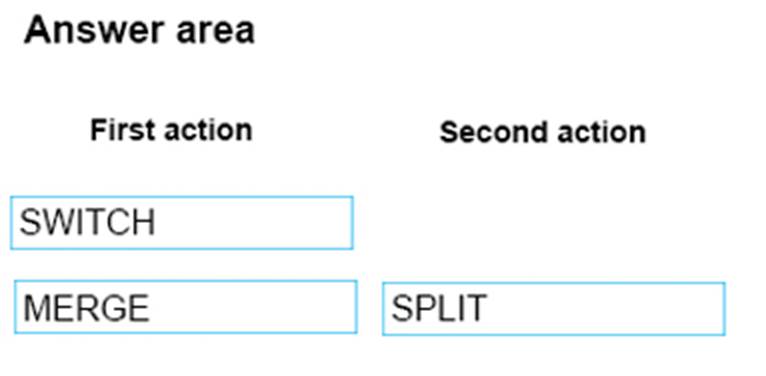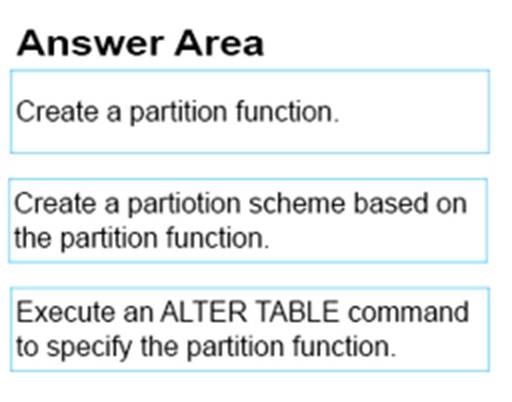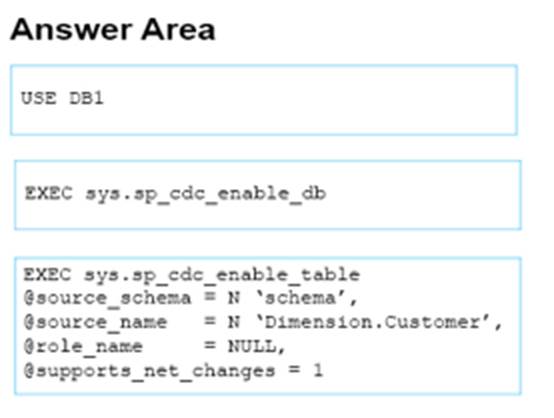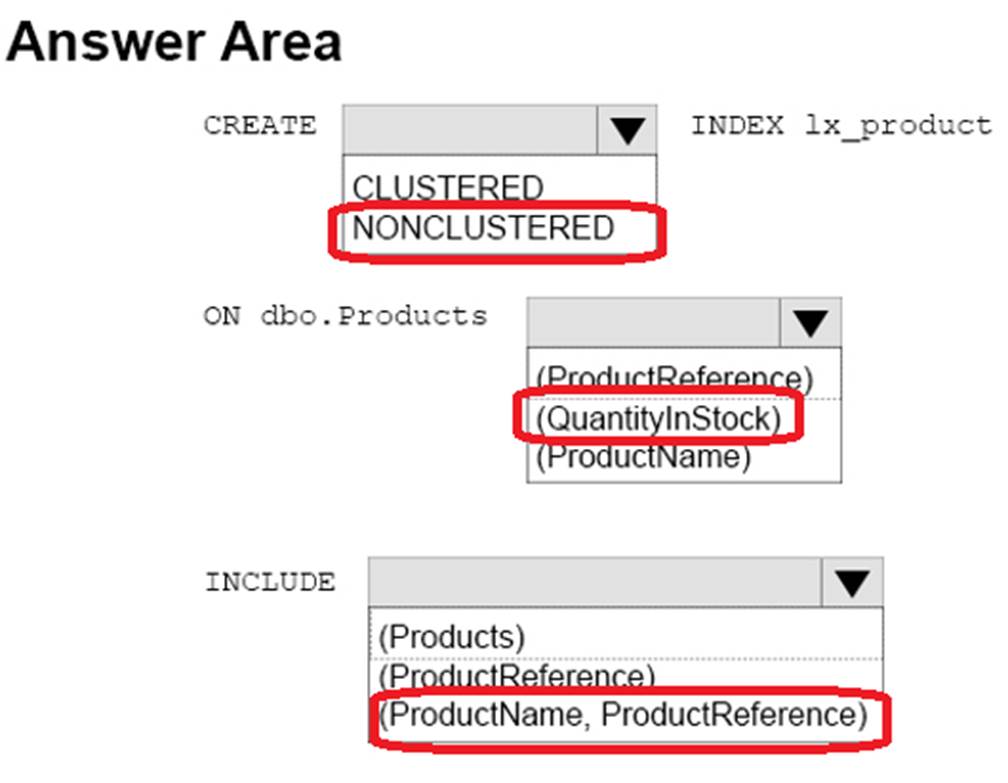Microsoft 70-767 Implementing a SQL Data Warehouse Online Training
Microsoft 70-767 Online Training
The questions for 70-767 were last updated at Dec 18,2025.
- Exam Code: 70-767
- Exam Name: Implementing a SQL Data Warehouse
- Certification Provider: Microsoft
- Latest update: Dec 18,2025
Note: This question is part of a series of questions that present the same scenario. Each question in the series contains a unique solution that might meet the stated goals. Some question sets might have more than one correct solution, while others might not have a correct solution.
After you answer a question in this sections, you will NOT be able to return to it. As a result, these questions will not appear in the review screen.
You have the following line-of-business solutions:
– If a change is made to the ReferenceNr column in any of the sources, set the value of IsDisabled to True and create a new row in the Products table.
– If a row is deleted in any of the sources, set the value of IsDisabled to True in the data warehouse.
One or more Microsoft SQL Server instances support each solution. Each solution has its own product catalog. You have an additional server that hosts SQL Server Integration Services (SSIS) and a data warehouse. You populate the data warehouse with data from each of the line-of-business solutions. The data warehouse does not store primary key values from the individual source tables.
The database for each solution has a table named Products that stored product information. The Products table in each database uses a separate and unique key for product records. Each table shares a column named ReferenceNr between the databases. This column is used to create queries that involve more than once solution.
You need to load data from the individual solutions into the data warehouse nightly. The following requirements must be met:
– Enable the Change Tracking for the Product table in the source databases.
– Query the cdc.fn_cdc_get_all_changes_capture_dbo_products function from the sources for updated rows.
– Set the IsDisabled column to True for rows with the old ReferenceNr value.
– Create a new row in the data warehouse Products table with the new ReferenceNr value.
Solution: Perform the following actions:
Does the solution meet the goal?
- A . Yes
- B . No
Note: This question is part of a series of questions that present the same scenario. Each question in the series contains a unique solution that might meet the stated goals. Some question sets might have more than one correct solution, while others might not have a correct solution.
After you answer a question in this sections, you will NOT be able to return to it. As a result, these questions will not appear in the review screen.
You are developing a Microsoft SQL Server Integration Services (SSIS) projects. The project consists of several packages that load data warehouse tables.
You need to extend the control flow design for each package to use the following control flow while minimizing development efforts and maintenance:
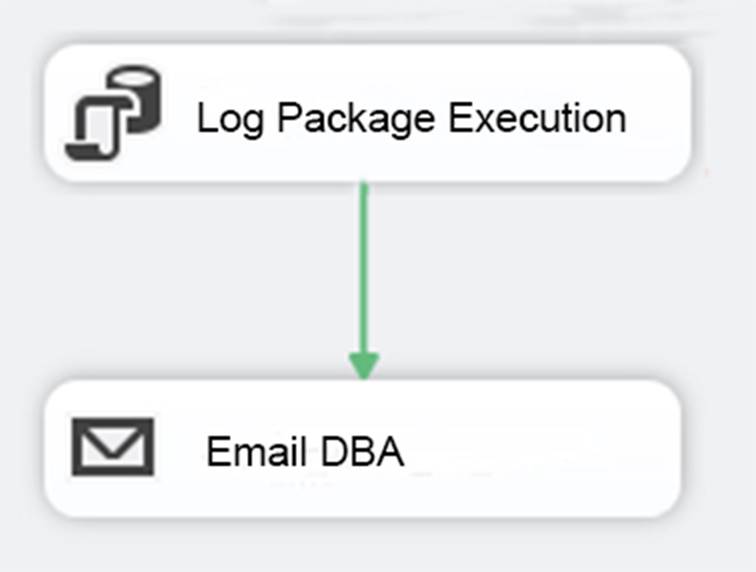
Solution: You add the control flow to a script task. You add an instance of the script task to the storage account in Microsoft Azure.
Does the solution meet the goal?
- A . Yes
- B . No
Note: This question is part of a series of questions that present the same scenario. Each question in the series contains a unique solution that might meet the stated goals. Some question sets might have more than one correct solution, while others might not have a correct solution.
After you answer a question in this sections, you will NOT be able to return to it. As a result, these questions will not appear in the review screen.
You are developing a Microsoft SQL Server Integration Services (SSIS) projects. The project consists of several packages that load data warehouse tables.
You need to extend the control flow design for each package to use the following control flow while minimizing development efforts and maintenance:
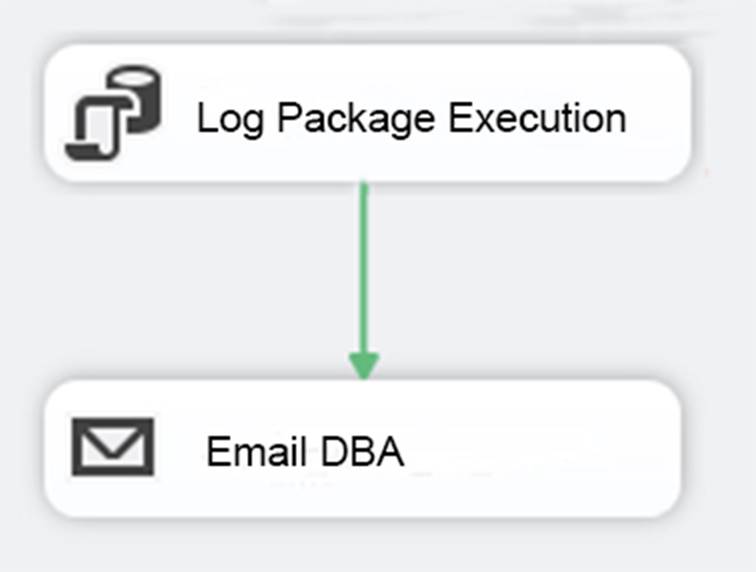
Solution: You add the control flow to an ASP.NET assembly. You add a script task that references this assembly to each data warehouse load package.
Does the solution meet the goal?
- A . Yes
- B . No
Note: This question is part of a series of questions that present the same scenario. Each question in the series contains a unique solution that might meet the stated goals. Some question sets might have more than one correct solution, while others might not have a correct solution.
After you answer a question in this sections, you will NOT be able to return to it. As a result, these questions will not appear in the review screen.
You are developing a Microsoft SQL Server Integration Services (SSIS) projects. The project consists of several packages that load data warehouse tables.
You need to extend the control flow design for each package to use the following control flow while minimizing development efforts and maintenance:
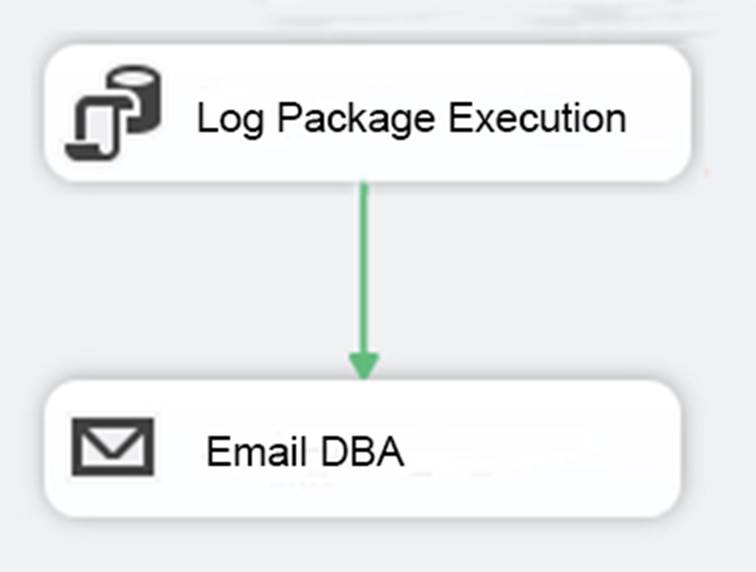
Solution: You add the control flow to a control flow package part. You add an instance of the control flow package part to each data warehouse load package.
Does the solution meet the goal?
- A . Yes
- B . No
DRAG DROP
Note: This question is part of a series of questions that use the same scenario. For your convenience, the scenario is repeated in each question. Each question presents a different goal and answer choices, but the text of the scenario is exactly the same in each question in this series.
You have a Microsoft SQL Server data warehouse instance that supports several client applications.
The data warehouse includes the following tables: Dimension.SalesTerritory, Dimension.Customer, Dimension.Date, Fact.Ticket, and Fact.Order. The Dimension.SalesTerritory and Dimension.Customer tables are frequently updated. The Fact.Order table is optimized for weekly reporting, but the company wants to change it daily. The Fact.Order table is loaded by using an ETL process. Indexes have been added to the table over time, but the presence of these indexes slows data loading.
All data in the data warehouse is stored on a shared SAN. All tables are in a database named DB1. You have a second database named DB2 that contains copies of production data for a development environment. The data warehouse has grown and the cost of storage has increased. Data older than one year is accessed infrequently and is considered historical.
You have the following requirements:
– Implement table partitioning to improve the manageability of the data warehouse and to avoid the need to repopulate all transactional data each night. Use a partitioning strategy that is as granular as possible.
– Partition the Fact.Order table and retain a total of seven years of data.
– Partition the Fact.Ticket table and retain seven years of data. At the end of each month, the partition structure must apply a sliding window strategy to ensure that a new partition is available for the upcoming month, and that the oldest month of data is archived and removed.
– Optimize data loading for the Dimension.SalesTerritory, Dimension.Customer, and Dimension.Date tables.
– Incrementally load all tables in the database and ensure that all incremental changes are processed.
– Maximize the performance during the data loading process for the Fact.Order partition.
– Ensure that historical data remains online and available for querying.
– Reduce ongoing storage costs while maintaining query performance for current data.
You are not permitted to make changes to the client applications.
You need to implement partitioning for the Fact.Ticket table.
Which three actions should you perform in sequence? To answer, drag the appropriate actions to the correct locations. Each action may be used once, more than once or not at all. You may need to drag the split bar between panes or scroll to view content.
NOTE: More than one combination of answer choices is correct. You will receive credit for any of the correct combinations you select.
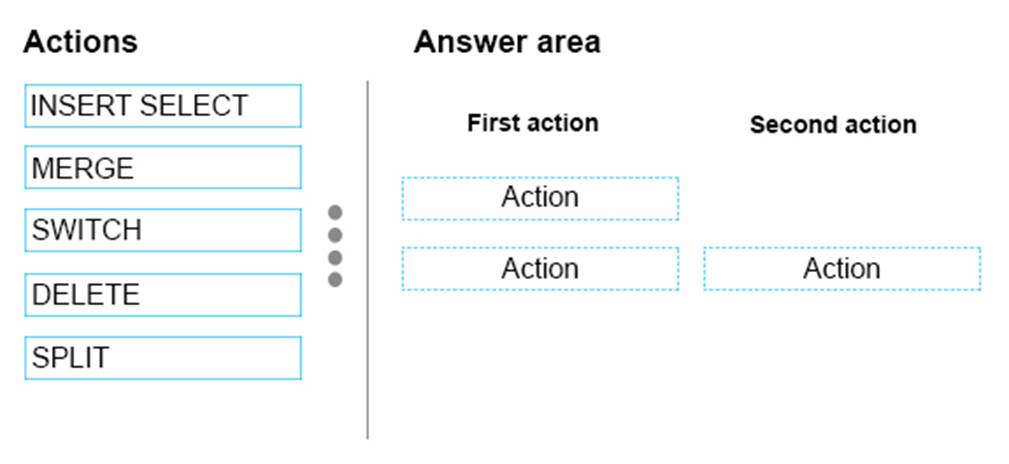
DRAG DROP
Note: This question is part of a series of questions that use the same scenario. For your convenience, the scenario is repeated in each question. Each question presents a different goal and answer choices, but the text of the scenario is exactly the same in each question in this series.
You have a Microsoft SQL Server data warehouse instance that supports several client applications.
The data warehouse includes the following tables: Dimension.SalesTerritory, Dimension.Customer, Dimension.Date, Fact.Ticket, and Fact.Order. The Dimension.SalesTerritory and Dimension.Customer tables are frequently updated. The Fact.Order table is optimized for weekly reporting, but the company wants to change it daily. The Fact.Order table is loaded by using an ETL process. Indexes have been added to the table over time, but the presence of these indexes slows data loading.
All data in the data warehouse is stored on a shared SAN. All tables are in a database named DB1. You have a second database named DB2 that contains copies of production data for a development environment. The data warehouse has grown and the cost of storage has increased. Data older than one year is accessed infrequently and is considered historical.
You have the following requirements:
– Implement table partitioning to improve the manageability of the data warehouse and to avoid the need to repopulate all transactional data each night. Use a partitioning strategy that is as granular as possible.
– – Partition the Fact.Order table and retain a total of seven years of data.
– – Partition the Fact.Ticket table and retain seven years of data. At the end of each month, the partition structure must apply a sliding window strategy to ensure that a new partition is available for the upcoming month, and that the oldest month of data is archived and removed.
– – Optimize data loading for the Dimension.SalesTerritory, Dimension.Customer, and Dimension.Date tables.
– – Incrementally load all tables in the database and ensure that all incremental changes are processed.
– – Maximize the performance during the data loading process for the Fact.Order partition.
– – Ensure that historical data remains online and available for querying.
– – Reduce ongoing storage costs while maintaining query performance for current data.
You are not permitted to make changes to the client applications.
You need to configure the Fact.Order table.
Which three actions should you perform in sequence? To answer, move the appropriate actions from the list of actions to the answer area and arrange them in the correct order.
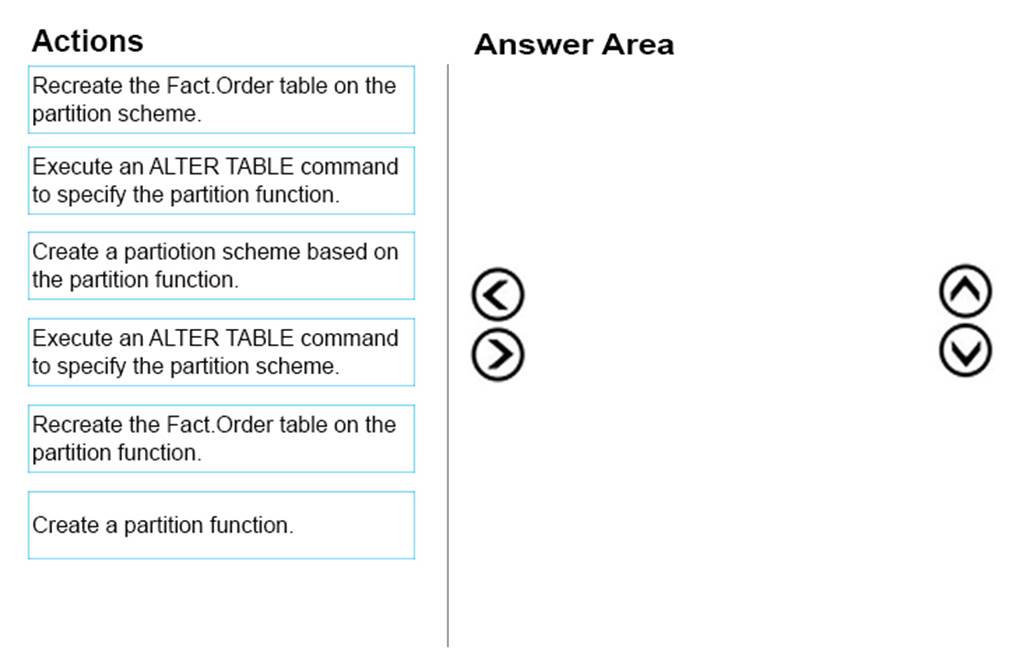
DRAG DROP
Note: This question is part of a series of questions that use the same scenario. For your convenience, the scenario is repeated in each question. Each question presents a different goal and answer choices, but the text of the scenario is exactly the same in each question in this series.
You have a Microsoft SQL Server data warehouse instance that supports several client applications.
The data warehouse includes the following tables: Dimension.SalesTerritory, Dimension.Customer, Dimension.Date, Fact.Ticket, and Fact.Order. The Dimension.SalesTerritory and Dimension.Customer tables are frequently updated. The Fact.Order table is optimized for weekly reporting, but the company wants to change it daily. The Fact.Order table is loaded by using an ETL process. Indexes have been added to the table over time, but the presence of these indexes slows data loading.
All data in the data warehouse is stored on a shared SAN. All tables are in a database named DB1. You have a second database named DB2 that contains copies of production data for a development environment. The data warehouse has grown and the cost of storage has increased. Data older than one year is accessed infrequently and is considered historical.
You have the following requirements:
– Implement table partitioning to improve the manageability of the data warehouse and to avoid the need to repopulate all transactional data each night. Use a partitioning strategy that is as granular as possible.
– Partition the Fact.Order table and retain a total of seven years of data.
– Partition the Fact.Ticket table and retain seven years of data. At the end of each month, the partition structure must apply a sliding window strategy to ensure that a new partition is available for the upcoming month, and that the oldest month of data is archived and removed.
– Optimize data loading for the Dimension.SalesTerritory, Dimension.Customer, and Dimension.Date tables.
– Incrementally load all tables in the database and ensure that all incremental changes are processed.
– Maximize the performance during the data loading process for the Fact.Order partition.
– Ensure that historical data remains online and available for querying.
– Reduce ongoing storage costs while maintaining query performance for current data.
You are not permitted to make changes to the client applications.
You need to optimize data loading for the Dimension.Customer table.
Which three Transact-SQL segments should you use to develop the solution? To answer, move the appropriate Transact-SQL segments from the list of Transact-SQL segments to the answer area and arrange them in the correct order.
NOTE: You will not need all of the Transact-SQL segments.
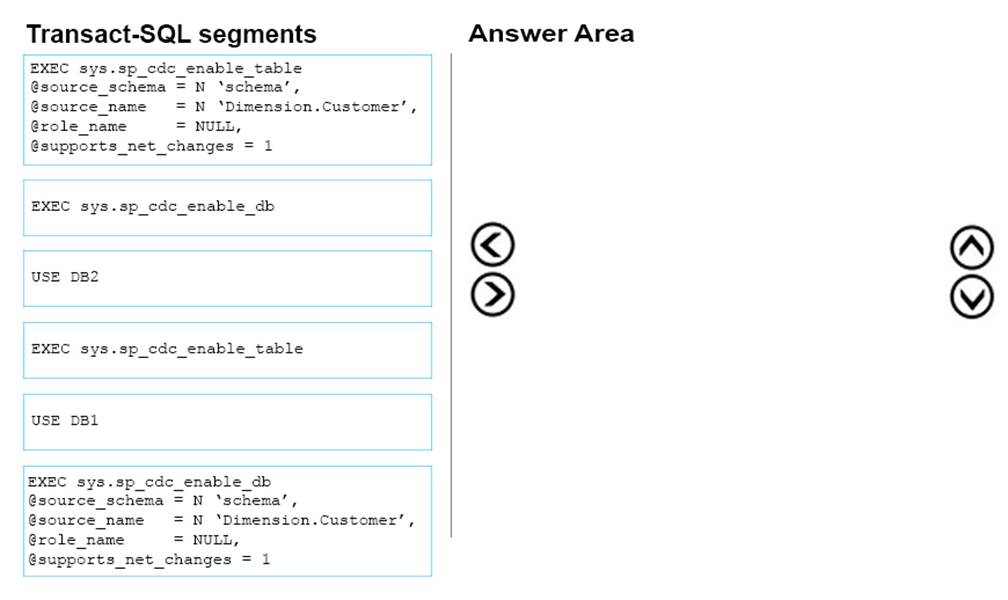
Note: This question is part of a series of questions that use the same scenario. For your convenience, the scenario is repeated in each question. Each question presents a different goal and answer choices, but the text of the scenario is exactly the same in each question in this series.
You have a Microsoft SQL Server data warehouse instance that supports several client applications.
The data warehouse includes the following tables: Dimension.SalesTerritory, Dimension.Customer, Dimension.Date, Fact.Ticket, and Fact.Order. The Dimension.SalesTerritory and Dimension.Customer tables are frequently updated. The Fact.Order table is optimized for weekly reporting, but the company wants to change it daily. The Fact.Order table is loaded by using an ETL process. Indexes have been added to the table over time, but the presence of these indexes slows data loading.
All data in the data warehouse is stored on a shared SAN. All tables are in a database named DB1. You have a second database named DB2 that contains copies of production data for a development environment. The data warehouse has grown and the cost of storage has increased. Data older than one year is accessed infrequently and is considered historical.
You have the following requirements:
– Implement table partitioning to improve the manageability of the data warehouse and to avoid the need to repopulate all transactional data each night. Use a partitioning strategy that is as granular as possible.
– Partition the Fact.Order table and retain a total of seven years of data.
– Partition the Fact.Ticket table and retain seven years of data. At the end of each month, the partition structure must apply a sliding window strategy to ensure that a new partition is available for the upcoming month, and that the oldest month of data is archived and removed.
– Optimize data loading for the Dimension.SalesTerritory, Dimension.Customer, and Dimension.Date tables.
– Incrementally load all tables in the database and ensure that all incremental changes are processed.
– Maximize the performance during the data loading process for the Fact.Order partition.
– Ensure that historical data remains online and available for querying.
– Reduce ongoing storage costs while maintaining query performance for current data.
You are not permitted to make changes to the client applications.
You need to implement the data partitioning strategy.
How should you partition the Fact.Order table?
- A . Create 17,520 partitions.
- B . Use a granularity of two days.
- C . Create 2,557 partitions.
- D . Create 730 partitions.
Note: This question is part of a series of questions that use the same scenario. For your convenience, the scenario is repeated in each question. Each question presents a different goal and answer choices, but the text of the scenario is exactly the same in each question in this series.
You have a Microsoft SQL Server data warehouse instance that supports several client applications.
The data warehouse includes the following tables: Dimension.SalesTerritory, Dimension.Customer, Dimension.Date, Fact.Ticket, and Fact.Order. The Dimension.SalesTerritory and Dimension.Customer tables are frequently updated. The Fact.Order table is optimized for weekly reporting, but the company wants to change it daily. The Fact.Order table is loaded by using an ETL process. Indexes have been added to the table over time, but the presence of these indexes slows data loading.
All data in the data warehouse is stored on a shared SAN. All tables are in a database named DB1. You have a second database named DB2 that contains copies of production data for a development environment. The data warehouse has grown and the cost of storage has increased. Data older than one year is accessed infrequently and is considered historical.
You have the following requirements:
You are not permitted to make changes to the client applications.
You need to optimize the storage for the data warehouse.
What change should you make?
- A . Partition the Fact.Order table, and move historical data to new filegroups on lower-cost storage.
- B . Create new tables on lower-cost storage, move the historical data to the new tables, and then shrink the database.
- C . Remove the historical data from the database to leave available space for new data.
- D . Move historical data to new tables on lower-cost storage.
HOTSPOT
You manage an inventory system that has a table named Products. The Products table has several hundred columns.
You generate a report that relates two columns named ProductReference and ProductName from the Products table. The result is sorted by a column named QuantityInStock from largest to smallest.
You need to create an index that the report can use.
How should you complete the Transact-SQL statement? To answer, select the appropriate Transact-SQL segments in the answer area.
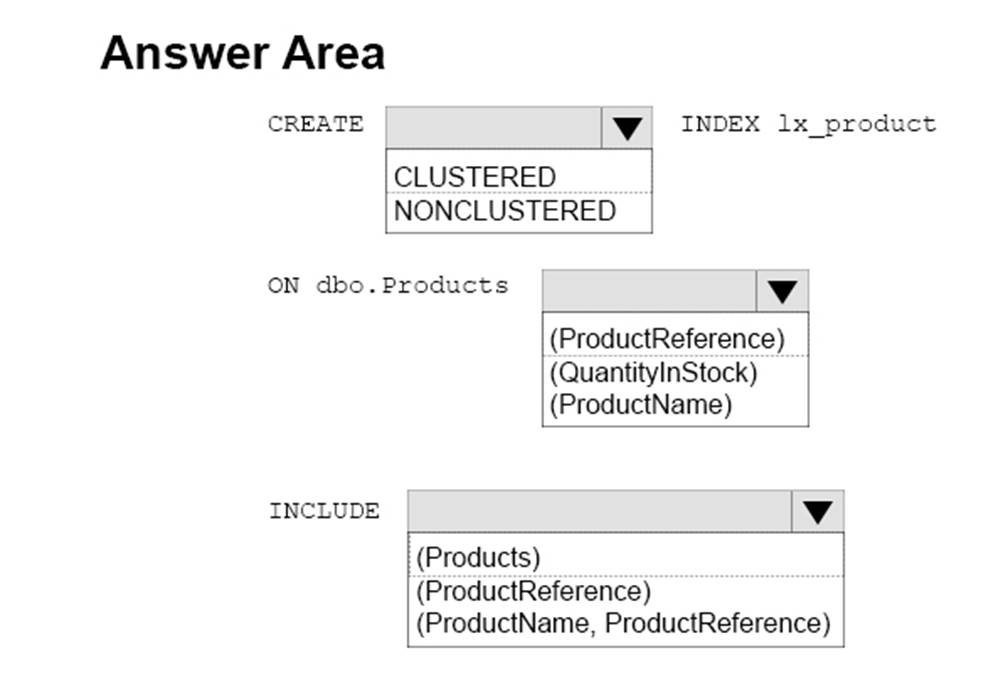
Latest 70-767 Dumps Valid Version with 136 Q&As
Latest And Valid Q&A | Instant Download | Once Fail, Full Refund

